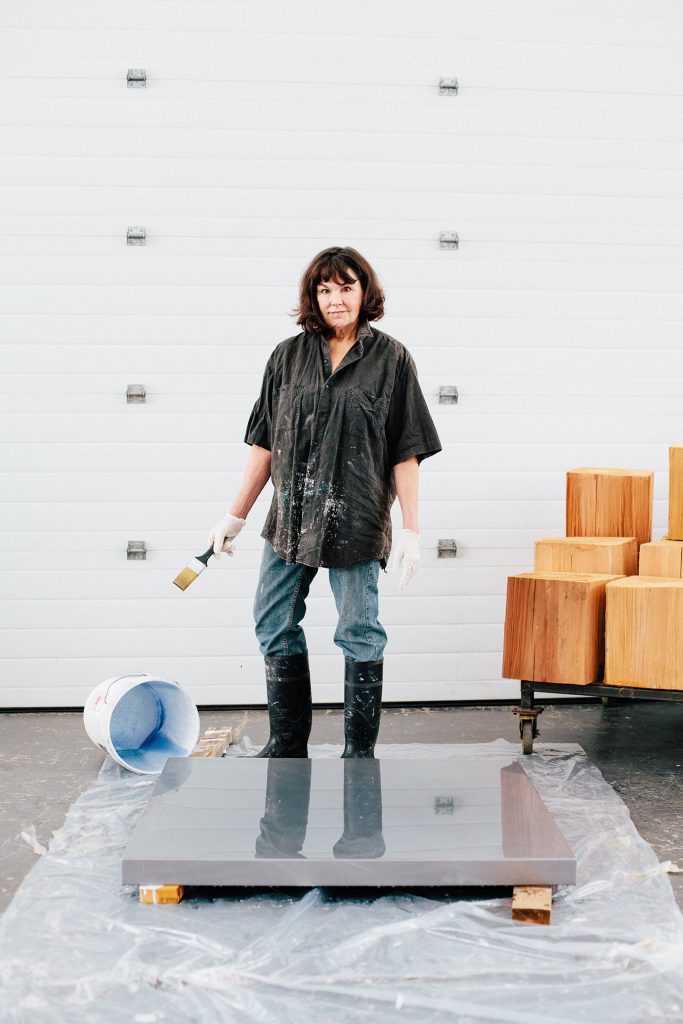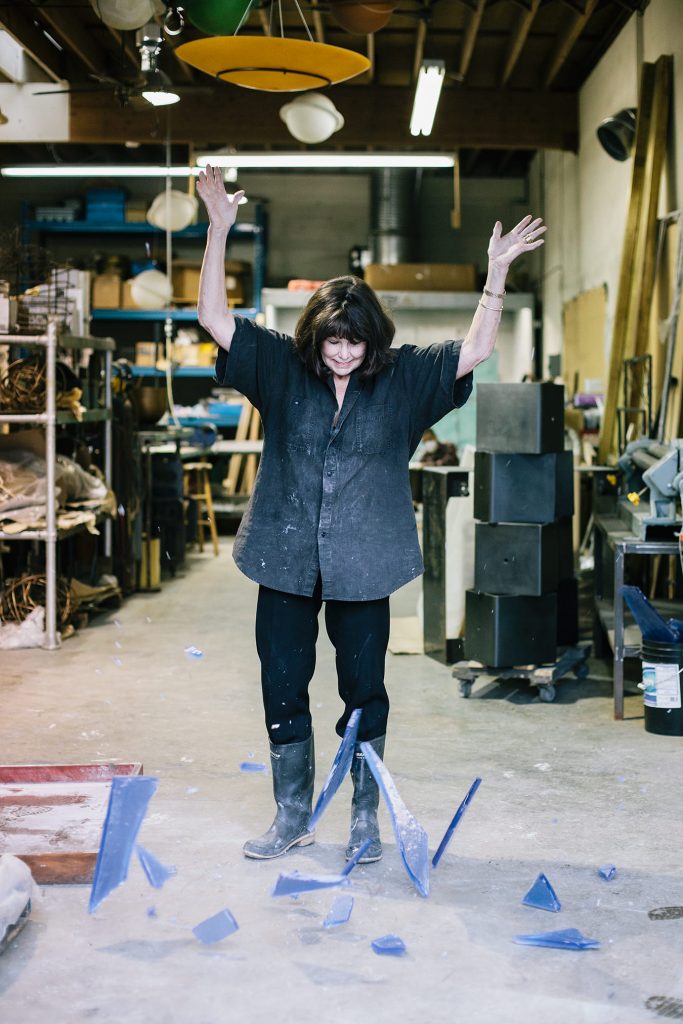It’s a wintry Wednesday morning in Pemberton, and a cloud thick with the promise of snow has settled over the valley, enveloping the Sturdy farm and acreage not unlike how a hen settles over her eggs. Beneath it, the world is profoundly still, a static sensation only experienced in Canada in January, when the bustle of the holiday season has been packed back into boxes and the promise of spring is remote. On this day, it’s as though even the inexorable change of the seasons has, for a moment, paused.
Two labs—one chocolate, one black—break the silence with their barks and slobbery greetings. Behind them, at the top of her back stairs, is Martha Varcoe Sturdy, recognizable by her trademark bob and fringe, dressed tidily in a black T-shirt and black quilted vest, dark blue jeans, and black leather riding boots.
“I’ve gone back to my roots,” she announces when we’re settled at the long dining room table. Sturdy graduated from Emily Carr University in sculpture, and today, she also holds an honorary doctorate from her alma mater. “Steel, brass, resin, wood: those are my materials. The reality is that I worked in my basement when I first started out as a sculptor trying to earn a living,” she remembers, laughing. “But I’ve got my company, which is still happening, and I have the freedom now to focus completely on art. So it’s very exciting for me.”
Her company, Sturdy Living, made Sturdy a household name. Her oversized brass and steel furniture, dramatic cast-resin pieces, and what she calls “wearable sculpture” jewellery continue to attract the attention of gallery curators, editors, stylists, and thousands of admirers worldwide. Over the years, she has designed accessories that have been purchased by fashion heavy hitters (including Gianfranco Ferré, Donna Karan, Oscar de la Renta, and Calvin Klein) for their runway shows, opened a studio/retail space in Vancouver’s South Granville neighbourhood, and travelled the world for both work and leisure.
At 71, Sturdy hasn’t left this other life behind, per se, but it’s safe to say that she is looking beyond it. “I don’t want to sound preachy, but with my life as I’ve lived it, I’ve now got a bit of wisdom, and instead of being in a hurry and always being so busy, maybe it’s more important to slow down and look and appreciate things that are, to a lot of people, completely insignificant.”
Her gaze shifts to a tree just beyond the window. “Look at how the snow is sitting on top of every single one of those branches. This is where I’m at in this time in my life.”
To her point: a diptych is hung in her hallway, a three-dimensional combination of sculpture and painting on steel frames that Sturdy half-jokingly says she’ll know is “too 3-D when it falls off the wall.” The piece could be a microcosm of a river, she explains. “It depends on how you interpret it. When a river’s frozen, then thaws, it all kind of jumbles and crashes together and overlays. That is the way it happens in winter, and what I’m trying to say is, isn’t that amazing?”
“Instead of being in a hurry and always being so busy maybe it’s more important to slow down and look and appreciate things that are, to a lot of people, completely insignificant.”
The work is from Sturdy’s new series, Break-Up, which will show at Winsor Gallery in Vancouver from May 8 to June 8. “Is it important to sell my art? Yes, because what the hell would I do with them all? So yes, I’m grateful, I’m happy,” she says of the upcoming exhibit. “When I was 40, if I got this? Whoop! Amazing! But I go riding with my horse, Porter, in the bush, and there’s a special tree that the bears learn to climb on. It’s a cedar tree in a forest, and it’s poised on an angle so that the cubs can go up it. That to me is really special.”
There’s surrender in her voice, but it’s not the sound of someone who has reluctantly acquiesced. No, Sturdy seems almost jubilant—calm and collected, but jubilant nonetheless—to have entered a time of self-awareness, which she somewhat ironically calls “the new Martha.” “You see, I thought I was unique, but not really,” she says, laughing. “I’m not new. Nothing’s new. You’re never new. You’re always a rerun—always—because everything has been thought of by someone somewhere in the world before you. And there’s a validity to understanding that, and what I’m doing is not analyzing what I’m doing and saying I’m going to be this or that—I’m just doing what I believe in at this time in my life.”
One of the things she clearly believes in is damn good food. For lunch, she dishes into simple, white bowls a tomato soup she’s made with onion and basil from her son Jordan’s farm (just up the road) and tomatoes and garlic she grew herself. The secret is to slow roast the tomatoes for a couple hours at 350ºF so they caramelize, she confides, and to “grow your garlic in horse shit” for the biggest, tastiest cloves. She also serves fresh bread on a cedar platter, and a wheel of creamy brie with a jar of homemade crabapple jelly made with apples grown by her daughter, Jessica.
Her farmhouse—actually a sawmill building that she and her husband, David Wardle, bought in 1990 and “added walls” to—has the same elegant approachability that one experiences being hosted by her and indeed that we see in her artwork. The open concept room with an 18-foot ceiling is filled with Sturdy’s own designs—a coffee and side tables, leather couches, resin lamps, and a dramatic brass wall mounting above the stone fireplace—while cowhide rugs break up the polished concrete floor. An oversized window brings the majesty of Pemberton in from
the outdoors.
Every morning she’s at the farm, which currently is about four days a week, Sturdy does 45 minutes of yoga and goes for a walk to take in the amazing natural environment around her. The practice provides her with the dexterity she needs to live her life of choice. “I’m not a passive grandmother,” she says. “I like to jump my horse. Plus, do you know how heavy steel canvases are?”
She negotiates ATVs and tractors about the acreage as easily as one can imagine her negotiating a one-on-one with a guest curator for London’s Tate Modern gallery, which she’s also recently done. “I was explaining to him what I’m trying to do, and he said that my philosophy reminded him of a centuries-old practice, originating in China, involving what’s called scholars’ rocks,” Sturdy says. These unique, naturally occurring rock formations were admired by Chinese philosophers and acted as a focal point for meditations. “These rocks symbolize the simplicity and natural beauty in life, and the practice of observing them is meant to slow you down to look around and appreciate nature.” Similarly, Sturdy’s artworks are a means for us to self-reflect.
Over the course of the morning, Sturdy repeatedly expresses concern that in sharing her honest and novel self, she’ll come across as pontificating or, in her words, a “bitchy, cranky old lady.” Not at all. Instead, she’s clearly allowing herself the luxury of a new adventure, and we, through her art, have the good fortune to tag along with her. “It’s the freedom to think,” Sturdy says. “I could be playing bridge.” She pauses. “No, I couldn’t.”




















